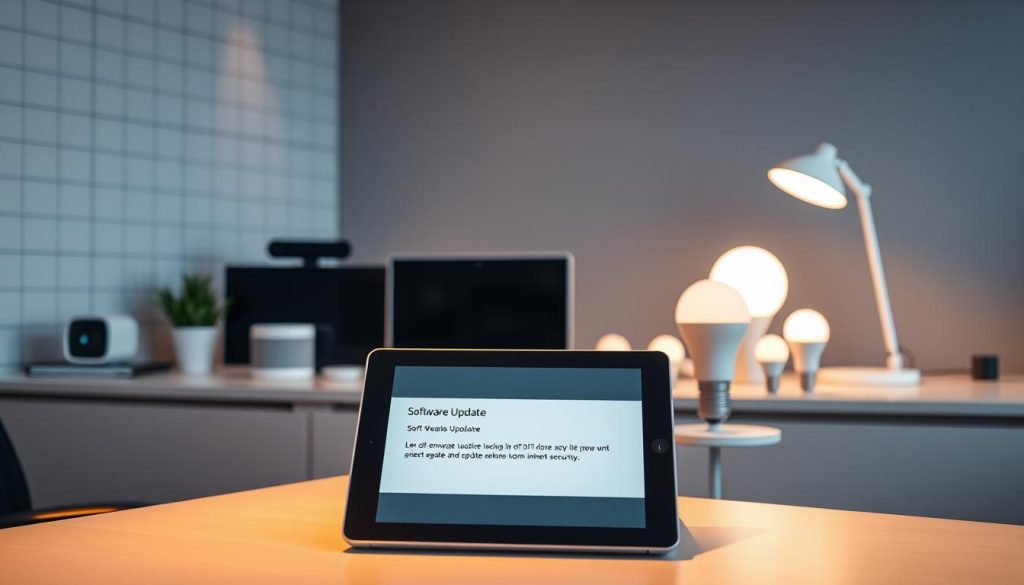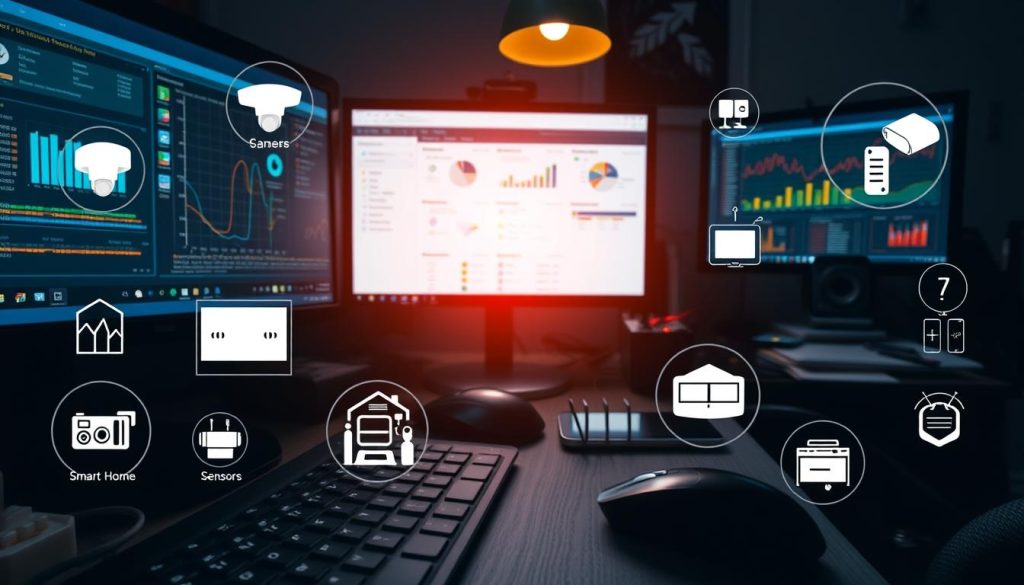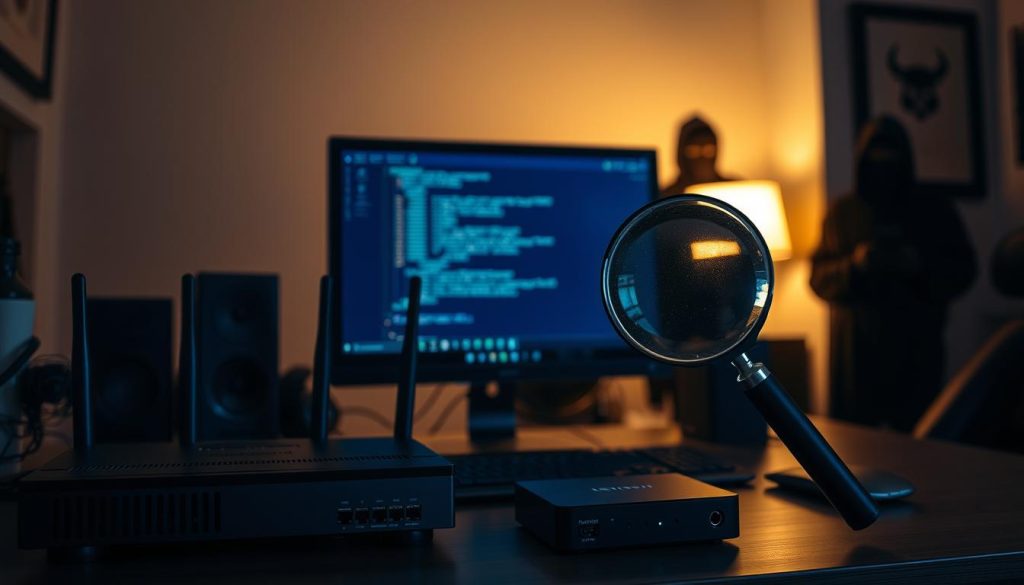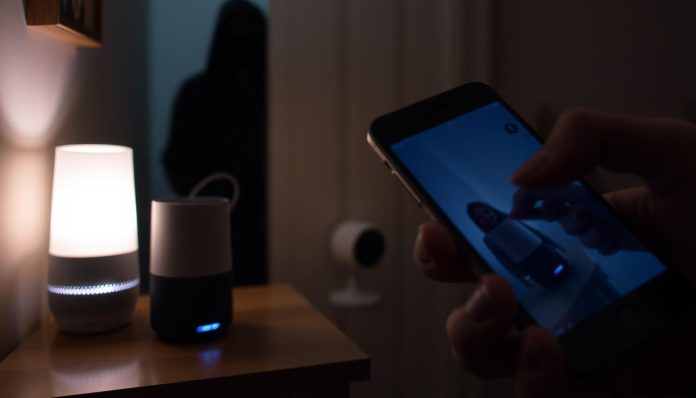You have many internet-connected devices at home. This includes Smart TVs, voice-controlled assistants, and smart speakers. Some baby monitoring systems can also be at risk of eavesdropping.
On average, an American home has about 17 internet-connected devices. This increases the risk of privacy concerns. It’s crucial to know these risks and protect your family’s privacy.
Key Takeaways
- Understand the eavesdropping risks associated with smart devices.
- Learn how to secure your baby monitoring systems.
- Discover ways to protect your privacy from smart speakers.
- Find out how to reduce eavesdropping risks on Smart TVs.
- Take steps to safeguard your family’s privacy at home.
Understanding Eavesdropping Risks with Smart Devices
Smart devices are now a big part of our lives. It’s important to know about the risks of eavesdropping. Devices like baby monitors, smart speakers, and TVs make life easier. But, they can also be a target for cyber threats because they connect to the internet.
What is Eavesdropping?
Eavesdropping means secretly listening to or getting someone else’s private info. With smart devices, this could mean someone else hearing your private talks or getting access to your data. They might even take control of your devices.
Types of Eavesdropping include when someone just listens (passive) and when they change or add to your data (active).
Common Vulnerabilities in Smart Devices
There are a few reasons why smart devices are at risk for eavesdropping:
- Weak Passwords: Using simple or default passwords makes it easy for hackers to get in.
- Outdated Software: Not updating your devices can leave them open to attacks.
- Inherent Security Flaws: Some devices have security problems because of how they were made.
To stay safe, it’s key to use strong Cybersecurity Measures. This includes updating your devices, using strong passwords, and being careful with what you share through them.
How Baby Monitors Can Be a Target
Baby monitors are key for parents today, but they can be hacked. As tech gets better, so do the risks. It’s important for parents to know the dangers and how to stay safe.
Types of Baby Monitors
There are many baby monitors out there, each with its own features and safety issues. Here are some common ones:
- Audio Monitors: These let parents hear their baby but don’t show video.
- Video Monitors: These offer both sound and video, giving a full view of the baby.
- Smart Monitors: These connect to Wi-Fi, letting parents watch their baby from a phone app.
- Movement Monitors: These track the baby’s movements and alert parents to any odd activity.
Smart monitors are the most handy but also the most at risk because they connect to the internet.
Security Breaches in Baby Monitors
Security issues with baby monitors can happen in several ways, including:
- Hackers can get into the monitor’s feed, gaining access to video and audio.
- They can find and use weaknesses in the monitor’s software or firmware.
- They can also intercept data sent between the monitor and the parent’s device.
These problems can lead to serious privacy issues and even harm if the hacker interacts with the baby or learns about the family’s routines.
Best Practices for Baby Monitor Security
To keep your baby monitor safe, follow these tips:
- Change Default Passwords: Always change the default passwords for your baby monitor and its app.
- Enable Two-Factor Authentication: If it’s available, turn on two-factor authentication for extra security.
- Keep Software Up to Date: Update the monitor’s firmware and app regularly to fix known issues.
- Use a Secure Wi-Fi Network: Make sure your home Wi-Fi is safe. Consider setting up a guest network for your IoT devices.
- Limit Remote Access: Turn off remote access when you don’t need it to lower hacking risks.
By knowing the risks and taking action, you can make your baby monitor much safer and protect your family’s privacy.
Smart Speakers: Advantages vs. Risks
Smart speakers are getting more popular, and it’s key to look at their good sides and risks. Devices like Amazon Echo and Google Home change how we use tech, making life easier and adding cool features.
Features That Help Protect Privacy
Many smart speakers have features to keep your privacy safe. You can mute the microphone when not in use to stop unwanted listening. Also, some devices let you review and delete voice recordings on the maker’s servers.
- Regularly review your voice recordings and delete them if necessary.
- Use the mute function when the speaker is not in use.
- Adjust privacy settings through the companion app.
Risks Posed by Smart Speakers
Smart speakers also have downsides, like unauthorized access to your voice data and eavesdropping. Hackers could even get into your smart home network through the speaker.
To lessen these risks, knowing how smart speakers work and what data they collect is important. This knowledge helps you make better privacy choices.
Securing Your Smart Speaker
To keep your smart speaker safe, start by changing the default settings and using a strong password for your account. Also, make sure to update your device’s software regularly to get the latest security fixes.
- Change the default device name and password.
- Enable two-factor authentication if available.
- Regularly check for and install software updates.
Smart TVs and Eavesdropping Threats
Smart TVs have become very popular, but they raise privacy concerns. These TVs connect to the internet and have cool features. But, they can be a risk if not handled right.

How Smart TVs Can Listen In
Smart TVs have voice control and Automatic Content Recognition (ACR). Voice control lets you use voice commands, but it can record private talks. ACR tracks what you watch, which helps build a data profile.
Voice Control: It makes using your TV easier. But, it means your TV is always listening. This could be a privacy issue if your data isn’t safe.
Safeguarding Your Smart TV
To protect your Smart TV, take a few steps. First, know how to change your privacy settings. Most TVs let you turn off voice control and ACR when you’re not using them.
- Regularly review and adjust your TV’s privacy settings.
- Disable voice control when not needed.
- Use a strong password for your TV’s account.
- Keep your TV’s software up to date.
Privacy Settings You Should Adjust
Changing your Smart TV’s privacy settings is key to keeping your info safe. Go to your TV’s settings and find data collection and voice control options. Turn off anything you don’t use often.
Also, check your TV’s manual or the manufacturer’s website for tips on setting up privacy.
Importance of Strong Passwords
To keep your smart home safe, it’s key to know how strong passwords help. Devices like baby monitors and smart TVs can be hacked if not locked down right.
Creating a Secure Password
A strong password is your first defense against hackers. It should mix letters, numbers, and symbols. Don’t use your name or common words that are easy to guess.
- Use a mix of characters, including uppercase, lowercase, numbers, and special characters.
- Avoid using personal information that can be easily guessed.
- Make sure your password is at least 12 characters long.
Changing Default Passwords
Many devices come with easy-to-find default passwords. Changing these is a must for security. Default passwords are a big risk if not updated, as hackers can easily get in.
Tips for Changing Default Passwords:
- Change the default password right away when you set up a new device.
- Use a password manager for unique, complex passwords.
- Keep updating your passwords to stay safe.
Using Two-Factor Authentication
Two-factor authentication (2FA) adds an extra layer of security. It requires a second form of verification, like a code or biometric scan.
Turning on 2FA makes your devices much safer. Even if a password is guessed, the second factor stops hackers.
Strong passwords, changed defaults, and 2FA can greatly improve your IoT security. This keeps your smart home safe from hackers.
Keeping Software Up to Date
Keeping your smart devices safe is easier than you think. Just make sure their software is always up to date. Software updates bring security patches that fix holes hackers could use. This keeps your devices safe from cyber threats.
Why Updates Matter
Updates do more than add new features. They keep your IoT devices secure and working right. They fix security holes that could let hackers in. So, by updating regularly, you keep your devices safe from cyber attacks.

How to Enable Automatic Updates
Enabling automatic updates is easy. It makes sure your devices always have the latest software. Here’s how to do it:
- Access the settings menu on your device.
- Look for the ‘Software Update’ or ‘System Update’ section.
- Enable the ‘Automatic Updates’ option.
With automatic updates, you don’t have to check for updates yourself. Your devices stay secure and up to date.
Checking for Firmware Updates
Firmware updates are important for your device’s hardware. They keep it working well and secure. Here’s how to check for firmware updates:
- Visit the manufacturer’s website.
- Search for your device model.
- Look for the ‘Support’ or ‘Downloads’ section.
- Check if there are any firmware updates available.
Always follow the manufacturer’s instructions when updating firmware. This helps avoid any problems.
Safe Networking Practices
A secure home network is key to a safe and connected home. Smart devices make life easier, but your network must be safe from hackers and snoops.
Protecting Your Wi-Fi Network
Your Wi-Fi network connects all your devices. Start by setting a strong and unique password. Don’t use your name, birthdate, or common words. A good password mixes letters, numbers, and symbols.
Also, change your Wi-Fi network’s name (SSID) to something that doesn’t give away your identity or device info.
Using a Guest Network
A guest network lets visitors use the internet without accessing your main network. This keeps your main network safe, especially with IoT devices.
IoT devices on a guest network are less likely to be hacked, protecting your main network.
Importance of Network Encryption
Network encryption makes data unreadable to anyone who intercepts it. Use WPA3 encryption to secure your Wi-Fi network.
Encryption keeps your data safe from hackers, protecting your privacy and security.
| Security Measure | Description | Benefit |
|---|---|---|
| Strong Password | A mix of characters, numbers, and symbols | Prevents unauthorized network access |
| Guest Network | Separate network for visitors and IoT devices | Segregates sensitive devices from potential threats |
| WPA3 Encryption | Latest security protocol for data transmission | Protects data from being intercepted and read |
Monitoring Device Activity
To keep your smart home safe, it’s important to watch how your devices act. This helps spot any odd behavior that could mean trouble. It’s a way to stay ahead of cyber threats.
How to Monitor Connected Devices
Watching your connected devices means checking their activity logs. You can do this through their app or web interface. For example, many smart home hubs let you see who’s talking to whom.
- Check device logs regularly for unusual activity.
- Use device management apps to monitor device status.
- Set up notifications for device activity.
Recognizing Suspicious Activity
Suspicious activity can show up in many ways. Like devices turning on or off by themselves. Or seeing devices you don’t know in your network. Knowing these signs helps you act fast.
| Suspicious Activity | Possible Indication |
|---|---|
| Devices turning on/off unexpectedly | Potential hacking or malware |
| Unfamiliar devices on your network | Unauthorized access |
| Unusual data usage patterns | Data breach or malware |
Tools to Enhance Your Monitoring
There are many tools to help you keep an eye on your devices. These include network monitoring software and apps for smart home security.

These tools have cool features like alerts and detailed logs. They let you manage all your devices from one place. Using them can make your smart home much safer.
Educating Family Members
In today’s world of smart homes, teaching your family about risks and safety is very important. It helps keep your Home Security and Cybersecurity Measures strong.
It’s key to share safety tips with everyone in your home. Talk about using strong passwords, spotting phishing scams, and keeping devices safe.
Sharing Best Practices with Family
Start by talking openly about devices connected to your network and their risks. Make sure everyone knows the basics of cybersecurity and how to protect their data.
- Talk about keeping software and firmware updated.
- Teach how to spot and avoid suspicious links or emails.
- Show how to use two-factor authentication.
Creating a Tech Usage Policy
Creating a tech policy helps set clear rules for device use. It should cover what’s okay and what’s not when using smart devices. This includes rules for app downloads, public Wi-Fi use, and sharing personal info online.
| Policy Area | Guidelines |
|---|---|
| Device Use | Limit screen time, avoid devices during meals or before bed. |
| App Downloads | Only download from trusted sources, check permissions. |
| Public Wi-Fi | Don’t use public Wi-Fi for sensitive stuff, use a VPN instead. |
Encouraging Open Communication
It’s important to create a space where family can talk about their worries or report odd activities. Regularly check in to make sure everyone is following the rules and to talk about new concerns.
By teaching your family and promoting cybersecurity awareness, you can greatly improve your home’s safety. Remember, Family Education is crucial for a safer smart home.
When to Seek Professional Help
Smart devices are now a big part of our lives. This means we face more risks of eavesdropping. Knowing when to get help from cybersecurity experts is key.
Identifying Signs of Eavesdropping
It’s important to know the signs of eavesdropping or device compromise. Look out for:
- Unusual device behavior, such as unexpected shutdowns or restarts
- Strange noises or echoes during phone calls
- Unexplained increases in data usage
- Devices turning on by themselves
If you see these signs, act fast to protect your privacy and security.
Consulting Security Experts
Cybersecurity experts can help a lot. They can:
- Do a deep security check on your smart devices
- Find and fix vulnerabilities
- Get rid of malware and other bad software
Getting help from experts ensures your devices are safe and your privacy is protected.
Services Offered by Professionals
Cybersecurity pros offer many services to keep your devices and data safe. Some include:
| Service | Description | Benefits |
|---|---|---|
| Device Security Audit | A detailed check of your device’s security settings and weak spots | Finds risks and suggests ways to improve |
| Malware Removal | Finding and removing bad software from your devices | Keeps your personal info safe and stops further harm |
| Security Patching | Applying fixes to make your device more secure | Makes your device safer and stops hackers |
Knowing when to ask for help and what services are out there helps you protect your devices and privacy.

Future Technology Trends and Eavesdropping
The world of smart devices and eavesdropping is changing fast. New tech will bring both new dangers and ways to fight eavesdropping.
Advances in Smart Device Security
Future smart devices will have better cybersecurity measures to stop eavesdropping. They will use stronger encryption and safer ways to talk to each other.
Companies will test their devices more to find and fix security problems early on.
Anticipated Threats and Solutions
With more IoT devices around, eavesdropping risks will grow. New, tricky malware and eavesdropping methods will appear.
To fight these, artificial intelligence and machine learning will be key. They can spot and handle security issues quickly, making devices safer.
The Role of Artificial Intelligence
Artificial intelligence will change how we deal with eavesdropping threats. AI can spot security risks by looking at patterns, helping us act fast.
AI security can also keep up with new threats, offering a flexible defense against eavesdropping.
Conclusion: Ensuring Privacy in a Smart Home
Securing your smart devices is key to protecting your privacy and keeping your home safe. With more connected devices, it’s important to know about cyber threats. Take steps to keep your digital life safe.
Securing Your Digital Life
To tackle privacy worries, use strong passwords and keep software updated. Also, be careful with your network. These actions help lower the chance of cyber attacks.
Staying Vigilant
Home security is a continuous task. Keep up with new ways to protect your smart devices. Check your device settings often and change them if needed to keep your privacy safe.
Empowering Your Family
Teach your family about the need for cybersecurity. Involve them in making your smart home secure. Together, you can make your digital space safer and more secure.

